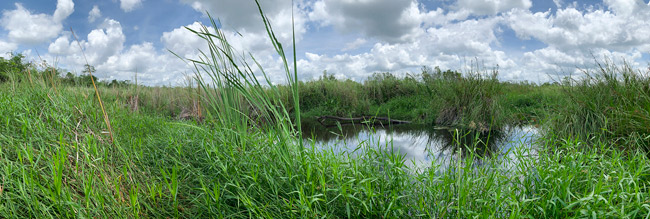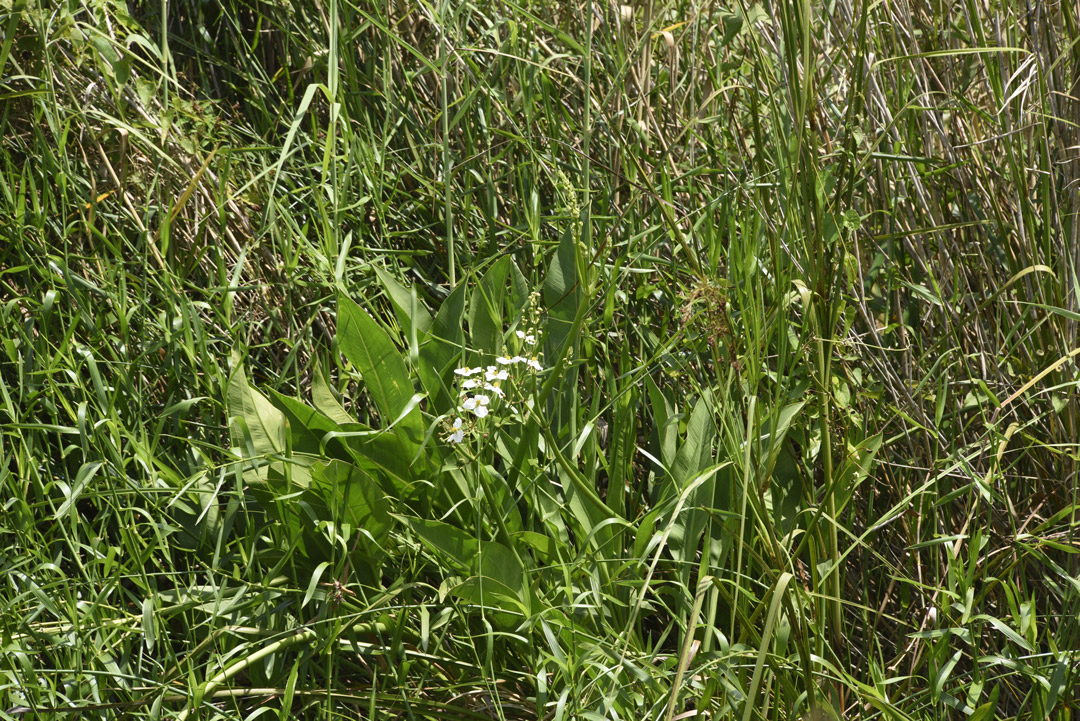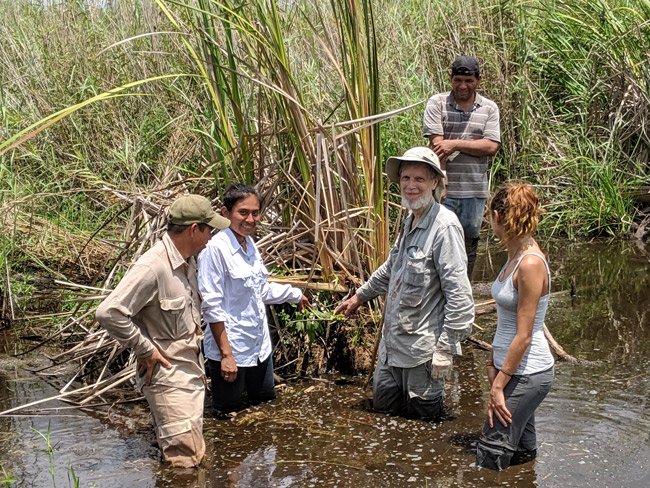Sagittaria lancifolia located in Parque Nacional Yaxha Nakum Naranjo
Photo by Dr Nicholas Hellmuth with an iPhone Xs.
This is a panorama of one of the stagnant pools of water around the edge of the Savanna of 3 Fern Species. This area has different amounts of water (or lack of water) every 50 to 100 meters. Some parts are a bog; some parts you can walk through easily (no water on the surface). Other parts (as you see here) are about 1 meter deep.
The single Sagittaria lancifolia is in the middle of the other wide of this pool of water. This plant has never been documented by any botanist who has visited the park.
Sagittaria species are common in marshes alongside rivers and creeks that feed into El Golfte area of Rio Dulce, Municipio de Livingston.
Photograph by Dr Nicholas Hellmuth, July 4, 2020.
Senaida Ba and the others waited until I found a way to get to this area. Once they saw I had made it there, they too came around to see what I had found. But about 3 or 4 meters before she reached the Sagittaria lancifolia plant that I was studying, she noticed a Habenaria repens orchid. I had not noticed this orchid since my eyes were glued on the noticeable white flowers of the Sagittaria lancifolia.
Our team consists of capable experienced park rangers from PNYNN co-administered team of CONAP and IDAEH, plus a visiting student from UVG. Full team personnel are listed by name in the full reports.
We have a separate page on the water-related Habenaria repens orchid
Turns out that both the Habenaria repens orchid and Sagittaria plant often grow near each other elsewhere
“Most commonly encountered here in North America is the water spider orchid (Habenaria repens). It is a relatively robust species, however, considering that even its flowers are green, it is often hard to spot. Though it will root itself in saturated soils along the shore, it regularly occurs in standing water throughout the southeast. Often times, it can be found growing amidst other aquatic plants like pickerel weed (Pontederia cordata) and duck potato (Sagittaria latifolia). Because it can reproduce vegetatively, it isn’t uncommon to find floating mats of comprised entirely of this orchid. “ (www.indefenseofplants.com/blog/2017/1/30/aquatic-orchids).
What is amazing is that his observations or comments he has read somewhere document that in North America grows “admidst other aquatic plants like…duck potato (Sagittaria latifolia). The Habenaria repens at the Yaxha park was growing 3 to 4 meters away from what Elena Siekavizza suggests is Sagittaria lancifolia.
So first let’s see if one is a synonym of the other:
- Sagittaria latifolia Willd. Is an accepted name, with 51 synonyms (www.theplantlist.org/tpl1.1/record/kew-287247).
- Sagittaria lancifolia L. is an accepted name, with 11 synonyms.
(www.theplantlist.org/tpl1.1/record/kew-287245).
Now lets see the botanical description by Standley and Steyermark:
Sagittaria lancifolia L. PI. Jam. Pug. 27. 1759. Figure 18.
In shallow water or in muddy soil about lakes or along streams, 600 meters or less; Alta Verapaz; Izabal; Jutiapa. Southern United States to Mexico and British Honduras; Honduras; Nicaragua; Costa Rica; Panama; West Indies; South America.
Plants large and coarse, glabrous, often a meter high or taller; leaves borne on long thick spongy petioles, erect, the blades lance-linear to elliptic, 20-50 cm. long, mostly 2-8 cm. wide, acute or acuminate, acute to long-attenuate at the base, conspicuously nerved; scapes simple or usually branched, the flowers on long slender spreading peduncles, the thin bracts lanceolate; corolla pure white, 2-4 cm. broad; fruit heads 1-1.5 cm. in diameter; achenes cuneate or obovate, short-rostrate, with a narrow dorsal wing.
(Standley and Steyermark 1958: 80). Notice that they do not list Peten for where this plant was known to them half a century ago. But any plant found in Mexico (on one side of Peten) and in Belize (on the other side of Peten) is logically most likely also present in Peten.
Balick, Nee and Atha list only Sagittaria lancifolia subsp. Lancifolia and S. lancifolia subsp. Media (2000: 173).
Sagittaria latifolia Willd. Sp. PI. 4: 409. 1806.
In marshes, at or little above sea level; Izabal. Southern Canada and United States to Mexico; Honduras; Nicaragua; Costa Rica; West Indies; South America. Hawaii (where introduced).
Plants glabrous, usually 30-60 cm. tall; leaves long-petiolate, the blades narrowly or broadly triangular-sagittate, 10-40 cm. long, acute or acuminate, the large basal lobes acute to attenuate; scapes simple or branched, the peduncles 1-5 cm. long, slender, the bracts ovate; petals large and white; fruit heads 1.5-3 cm. in diameter; achenes very numerous, obliquely obovate, winged, with a horizontal apical beak.
Called “arrow-head” in the United States, in reference to the shape of the leaves. The starchy rhizomes were used as food by many of the North American Indians. (Standley and Steyermark 1958: 80).
So Sagittaria latifolia is not listed for Peten; listed only for Izabal. Neither species of Sagittaria is listed in the index of Lundell (1937: 239). Family Alismataceae is not in the plant family index of Atran et al. 2004. So two leading botanical surveys of Peten seemingly did not find any species of Sagittaria (unless Lundell uses one of the 51 synonyms that is not Sagittaria genus. Also no Sagittaria plant in the plant index of Cook’s excellent coverage of plants of the Lacandon area of Chiapas, Mexico.
So seems like it was worth wading across the water area to take photos (this is not Lake Yaxha, this is a mixed ecosystem of bog, cibal, fern savanna, and swamp; all this is high high above the series of lakes). The only lake at this elevation in the park is Laguna Perdida, about 50 meters north of the north edge of Savanna of 3 Fern Species.
But no way that Sagittaria is not found by anyone anywhere in Guatemala, Belize, or Chiapas (and is certainly in Quintana Roo as well, and Tabasco). So let’s do more research:
If Sagittaria is in most wet areas of the Maya Lowlands, it will be in Chiapas even if not in the research area of one botanist. So Sagittaria lancifolia is indeed found in the Lacandon areas of Chiapas (Levy et al. 2006: 96)
Sagittaria lancifolia is indeed known for Belize; it is listed for almost every different kind of wetland ecosystem: Bridgewater et al. 2002: 430. Also listed on p. 427 and 435. Meerman and Sabido also note Sagittaria lancifolia for marshy ecosystems (2001: ecosystem #65, page 66).
Peraza et al. lists Sagittaria lancifolia for Tabasco (2019: 5).
For Campeche it is Sagittaria guayanensis Kunth ssp. Guayanensis which is listed (Gutiérrez et al. 2016: 2). A report on the Biosfera Calakmul (a few kilometers into Campeche, Mexico, north of El Mirador, Peten) list three species (Instituto Nacional de Ecología 1999: 175):
- Sagittaria guyanensis H. B. K. subsp. Guyanensis
- Sagittaria intermedia M. Micheli subsp. Media (M. Micheli) Bogin
- Sagittaria lancifolia L. subsp. Lancifolia (accepted name)
Sagittaria guyanensis Kunth is a synonym of Sagittaria guayanensis Kunth
Corona (2013: 55) lists Sagittaria for Rio Dulce, Izabal area.
Reyes (2009: 35, 50) mentions Sagittaria longiloba for food (but so far Sagittaria lancifolia is not regularly listed as food whatsoever in lists of edible Maya plants). However, in theory, the tubers of Sagittaria lancifolia are potentially edible (Zepeda and Lot 2005). Just that today there is so much tasty junk food plus fruits and vegetables from other parts of the world.
Reyes also mentions that Sagittaria has not been listed for the Peten chain of lakes in the past. On page 61 she lists Sagittaria lancifolia. She lists it for Aguada Zotz (page 73, not in the laguna category). Most other books and articles use the word Laguna Zotz.
Here are places where Sagittaria lancifolia has been found in Peten two decades ago:
- Sagittaria lancifolia, Pantano Pejelargarto, La Libertad, Peten (Dix and Fernandez 2001: 25).
- Sagittaria lancifolia, Pantano La Vaca, La Libertad, Peten (Ibid: 25).
- Sagittaria lancifolia, Pantano Campo Verde, La Libertad, Peten (Ibid: 26).
- Sagittaria lancifolia, Pozas Azules, La Libertad, Peten (Ibid: 40).
- Sagittaria lancifolia, Laguna La Gloria, La Libertad, Peten (Ibid: 40).
- Sagittaria lancifolia, Lagunita El Repasto, La Libertad, Peten (Ibid: 41).
- Sagittaria lancifolia, Lagunita Las Cuaches, La Libertad, Peten (Ibid: 42).
- Sagittaria lancifolia, Lagunita Lacandon, La Libertad, Peten (Ibid: 42).
- Sagittaria lancifolia, Lagunita La Pita, La Libertad, Peten (Ibid: 45).
And more locations that there is space to list: 55, 56, 57, 58, 135, 136, 139, 140 - Sagittaria lancifolia, Rio San Pedro, western Peten (Ibid:92).
- Sagittaria lancifolia, Arroyo Pucte, tributary of Rio de la Pasion, Peten (Ibid: 141).
So their team found it in more than 20 locations in the Municipio La Libertad, but they admit they did no research around Lake Yaxha; Rio Ixtinto is not in their index (unless spelled differently).
In November 2020, we found more Sagittaria plants in swamps of Municipio de Livingston, Izabal
While taking a motor boat up and down every river and creek that flows into El Golfete, we saw and photographed Sagittaria plants in the wetlands of the Municipio de Livingston, Izabal, Guatemala. We will have a full pdf with photographs ready by late January 2021. This will have an updated expanded bibliography.
Summary and Conclusions on Sagittaria lancifolia
It really helps to do field work in Parque Nacional Yaxha and Nakum Naranjo (PNYNN) to find plants that have not been noted in this park previously. Dix and Fernandez also do not list this plant for the Parque Nacional Tikal, though there are wet areas there as well. We are curious to learn about plants present in the Yaxha park but not documented for the Tikal park.
There are several species of Sagittaria in Guatemala. Of these at least Sagittaria lancifolia is at Yaxha.
PDF, Articles, Books on Sagittaria lancifolia and other Sagittaria of Mexico and Guatemala
- 2000
- Checklist of the Vascular Plants of Belize: With Common Names and Uses. Memoirs of the New York Botanical Garden Vol. 85. 246 pages.
- 1955
- Revision of the Genus Sagittaria (Alismataceae)”, Mem. New York Botanical Garden.(2): 179-233.
- 2002
- Vegetation classification and floristics of the savannas and associated wetlands of the Rio Bravo conservation and management area, Belize. Edinburgh Journal of Botany. Vol. 59, No. 3. Pages 421-442.
Sold online:
www.cambridge.org/core/journals/edinburgh-journal-of-botany/article/vegetation-classification-and-floristics-of-the-savannas-and-associated-wetlands-of-the-rio-bravo-conservation-and-management-area-belize/49CC6B627770ECB6A051C34DA5527B78
- 1907
- The embryology of Sagittaria Lancifolia. The Ohio Naturalist. Vol. VII, No. 5. Pages 97-101.
Available online:
https://kb.osu.edu/bitstream/handle/1811/1557/v07n05_097.pdf?sequence=1
- 2013
- Parque Nacional Río Dulce: Habitat importante para la conservación del manatí Antillano Trichechus manatus manatus (Sirenia: Trichechidae) Vol. 4.
Available online:
http://c3.usac.edu.gt/admin_revindex/articulos/editor7-r110_pi50_pfi59_ra190Ensayo3.pdf
- 2001
- Inventario Nacional de los Humedales de Guatemala. UICN Mesoamérica: CONAP: USAC, 176 pages.
176 pages of great documentation (for many wet areas other than Yaxha, Sacnab, not to mention all the bogs and all the other wet areas deep into the park). Here is what is stated for Yaxha:
Clasificación: pendiente
Localización: pendiente
Coordenadas: pendiente
Area: pendiente
Altitud: pendiente
Tipo de humedal: pendiente
Comunidad: SABANA LA LIBERTAD
Especies de flora: Pendiente
- 2015
- The Maya Forest Garden. Eight Millennia of Sustainable Cultivation of the Tropical Woodlands. Left Coast Press, 260 pages.
- 2013
- A checklist of the vascular plants of the lowland savannas of Belize, Central America. Phytotaxa 101 (1): 1–119.
Available online:
www.eeo.ed.ac.uk/sea-belize/outputs/Papers/goodwin.pdf
- 2017
- Ecología de la comunidad de plantas hidrófitas en Tumilco, municipio de Tuxpan, Veracruz. Universidad Veracruzana. 67 pages.
Available online:
www.uv.mx/pozarica/mca/files/2019/05/G04_FIDEL-GARCIA-FALCON.pdf
- 2016
- Listado florístico del municipio de Campeche, México. Foresta Veracruzana. Vol. 18, No. 1. Pages 1-16.
- 1994
- The Alismataceae. Flora Neotropica, Mon. 64: 1-112.
- 1999
- Programa de Manejo de la Reserva de la Biosfera Calakmul. Instituto Nacional de Ecología. 273 pages.
- 2006
- Aspectos florísticos de Lacanhá Chansayab, Selva Lacandona, Chiapas Acta Botánica Mexicana. No. 77. Pages 69-98.
- 1983
- Notas sobre la interpretación botánica de plantas acuáticas representadas en Códices mexicanos”, en Peterson, J. F. 44 Congreso Internacional de Americanistas, Manchester 1982: Imágenes de flora y fauna de culturas precolombinas: Iconografía y Función. Bar. International Series. 171: 85-91.
- 1999
- Catálogo de angiospermas acuáticas de México: hidrófitas estrictas emergentes, sumergidas y flotantes. Cuadernos del Instituto de Biología 33, UNAM. 161 pages.
- 1937
- The Vegetation of Peten. Carnegie Institution of Washington, Publ. 478. Washington. 244 pages.
- 1938
- Plants Probably Utilized by the Old Empire Maya of Peten and Adjacent Lowlands. Papers of the Michigan Academy of Sciences, Arts and Letters 24, Part I:37-59.
Available online:
www.botanicalsciences.com.mx/index.php/botanicalSciences/article/download/1660/1309/
- 2006
- Biology and management of Sagittaria latifolia Willd (Broad-leaf arrow-head) for wetland restoration and creation. Restoration Ecology. Vol. 1, No. 4. Pages 248-255.
Available online:
www.researchgate.net/publication/229498116_Biology_and_Management_of_
Sagittaria_latifolia_Willd_Broad-leaf_Arrow-head_for_Wetland_Restoration_and_Creation
- 2001
- Central American Ecosystems Map Belize, Vol. II: Ecosystem Descriptions. Programme for Belize.
- 1980
- Plantas acuaticas utilizadas del Value de Mexico. Thesis, UNAM. 88 pages.
- 2015
- Native aquatic and wetland plants: duck potato, Sagittaria lancifolia. University of Florida. 3 pages.
Available online:
https://edis.ifas.ufl.edu/pdffiles/AG/AG40300.pdf
- 2003
- Alismataceae. Flora del Bajío y de regiones adyacentes. Fascículo 11. 23 pages.
Available online:
http://inecolbajio.inecol.mx/floradelbajio/documentos/fasciculos/
ordinarios/Alismataceae%20111.pdf
- 2012
- Dynamic performance of a constructed wetland to treat lindane-contaminated water. International Research Journal of Engineering Science, Technology and Innovation. Vol. 1, No. 2. Pages 57-65.
Available online:
https://pdfs.semanticscholar.org/f67c/73bd6fb6db31b64d33e0dc0abd75bc2d1450.pdf
- 2019
- The Marceño Agroecosystem: Traditional Maize Production and Wetland Management in Tabasco, Mexico. Sustainability No.11.
- 1995
- Selection of native wetland plants for water treatment of urban runoff. UC Berkeley. 32 pages.
Available online:
https://escholarship.org/content/qt33q2m802/qt33q2m802.pdf?t=lnoz7n
- 2009
- Los cuerpos de agua de la Region Maya Tikal-Yaxha: importancia de la vegetación acuática asociada, calidad de agua y conservación. Universidad de San Carlos de Guatemala. 71 pages,
Available online:
https://digi.usac.edu.gt/bvirtual/informes/puirna/INF-2009-047.pdf
Very helpful, but their team visited only Laguna Yaxha and Laguna Sacnab; none of the other watery areas. Rio Ixtinto is also not listed (p. ii). Again documentation that no botanist has taken notes in the swamp-savanna-cibal area a few meters south of Laguna Perdida (which is uphill to the north of Laguna Lankaja (spelled many ways)).
- 2001
- Gender variation in Sagittaria latifolia (Alismataceae): is size all that matters? Ecology. Vol. 82, No. 2. Pages 360-373.
Available online:
http://labs.eeb.utoronto.ca/BarrettLab/pdf/SCHB_177.pdf
- 1936
- The Forests and Flora of British Honduras. Field Museum of Natural History. Publication 350, Botanical Series Volume XII. 432 pages plus photographs.
- 1923
- Trees and Shrubs of Mexico. Contributions from the United States National Herbarium, Volume 23, Part 3. Smithsonian Institution.
- 1958
- Flora of Guatemala. Fieldiana; botany, Volume 24, Part I. Chicago Museum of Natural History.
- 2000
- Plant guide: broadleaf arrowhead Sagittaria latifolia Willd. USDA. 4 pages.
Available online:
https://plants.usda.gov/plantguide/pdf/cs_sala2.pdf
- 2000
- Endemismo florístico en la reserva de la biosfera Sierra de las Minas. USAC.
Unfortunately the PDF is locked, so no way to show the information without having to hand type each letter, each word, each list.
Available online:
http://glifos.concyt.gob.gt/digital/fodecyt/fodecyt%201999.69.pdf
- 1904
- Plantas comestibles de los antiguos mexicanos. Museo Nacional. Mexico.
- 2016
- Checklist of the native vascular plants of MexicoCatálogo de las plantas vasculares nativas de México. Revista Mexicana de Biodiversidad 87 (2016) 559–902.
Available online:
http://revista.ib.unam.mx/index.php/bio/article/view/1638/1296
- 2005
- Distribución y uso tradicional de Sagittaria macrophylla Zucc. y S. latifolia Willd. en el Estado de México Ciencia Ergo Sum. Vol. 12. No. 3. Pages 282-290.
Available online:
www.redalyc.org/pdf/104/10412308.pdf
Web pages with nice photographs and/or helpful info on Sagittaria lancifolia, arrowhead, duck potato
www.cabi.org/isc/datasheet/109160
Information.
https://plants.ifas.ufl.edu/plant-directory/sagittaria-lancifolia/
Photos.
www.theplantlist.org/tpl1.1/record/kew-287245
Synonyms.
http://web.fscj.edu/David.Byres/duckpot/duckpot.htm
Two large photos on two pages (you have to click at the bottom to reach the second page). As typical of most web pages on Sagittaria lancifolia, photos are from Florida.
www.wildflower.org/plants/result.php?id_plant=SALA
Information and photos.
Most recently updated, January 11, 2021
Bibliography and text update by Nicholas Hellmuth, FLAAR Mesoamerica
First posted, August 2019
Bibliography prepared by Marcella Sarti, FLAAR Mesoamerica
















































































